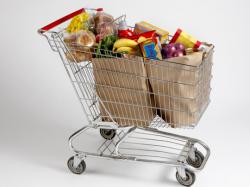Shoppers Diversify Stores, Add Trips As Food Costs Climb
May 3, 2012 | 3 min to read

Madison, WI — Food prices continue to rise, reflecting higher input costs, while consumers do their best to spend less on staple goods, according to What’s in Store 2012, an annual trends publication of The International Dairy- Deli-Bakery Association™ (IDDBA). All types of retailers are reacting with more food offerings as shoppers hunt for the best deals to get more bang for their buck. What’s in Store is a secondary research trends report compiled from over 150 credible industry resources.
The U.S. Department of Agriculture’s Consumer Price Index anticipates food prices will climb faster than general inflation. Food-at-home (grocery store) prices are anticipated to rise from 3.5% to 4.5%, while food-away-from home (restaurant) prices are expected to rise 3%-4%, the USDA forecasted. The U.S. food and beverage market is expected to grow from 1%-1.5% in 2011 and from 1.8%-2.2% in 2012, SymphonyIRI reported.
Consumers’ attempts to negate higher prices with more frequent, immediate shopping trips for low-value, instant needs is turning the retail world on its head. These fill-in trips are occurring more frequently at supercenters, though routine and stock-up trips are down at those outlets. However, grocery stores are seeing more fill-in, routine, and stock-up trips. Warehouse clubs see less routine and stock-up trips, but more immediate trips. Supermarkets lost share to non-traditional grocery retailers in 2010 as mass, drug, and dollar formats expanded their food items to attract shoppers.
Smaller-format grocery stores, with as few as 10,000-13,000 square feet, are propping up sales and falling in line with the weak economic environment. Stores expect to have fewer employees, but more affordable prepared foods and service departments. These stores, like WalMart’s Neighborhood Market, are in hip locations in major metropolitan areas. Larger-format stores, such as Target’s PFresh locations, have expanded their grocery layout to include fresh produce and more private label and store-brand food items. Dollar stores, which saw sales grow by 8.8% in 2010, are likely to achieve more gains with their newly expanded food selections and private label products. More online ordering and delivery services are available through supermarket chains. Even convenience stores have joined the ‘get healthy’ trend by offering juices, fruits, yogurt, nuts, and salads.
What's in Store 2012, our 26th edition, is a 200+ page trends report that details consumer and industry trends affecting the dairy case, cheese case, bakery, deli, and foodservice supermarket departments. The report along with its 185+ tables was developed in cooperation with leading industry companies, publications, press and Web services and associations. It includes department sales, per capita consumption, consumer preferences, and random-weight, UPC, and private label sales data. The full report is available from IDDBA. The cost is $99 for IDDBA members and $399 for non-members, plus shipping and handling. Along with the book, readers have access to What's in Store Online, featuring over 50 quarterly-updated, downloadable, color sales tables with random-weight (PLU), UPC, and system 2-coded data. In addition, the Web site offers timely white papers, trends articles, and links for all of the businesses that are referenced in the What's in Store book. For more information, or to order, call the IDDBA Education Department at 608.310.5000 or visit the organization's Web site, www.iddba.org.
About IDDBA: IDDBA is a nonprofit membership organization serving the dairy, deli, bakery, cheese, and supermarket foodservice industries. Member companies enjoy many benefits and services including the annual seminar and expo, leading-edge research, training programs, management tools, and an annual trends report. For more information, contact IDDBA at 608.310.5000 or visit our Web site, www.iddba.org.
Source: The International Dairy•Deli•Bakery Association™
